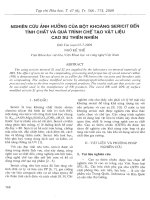Ảnh hưởng của chỉ số axit của dầu hạt cao su Việt Nam tới quá trình epoxy hóa
Bạn đang xem bản rút gọn của tài liệu. Xem và tải ngay bản đầy đủ của tài liệu tại đây (4.32 MB, 5 trang )
T p chí Khoa h c và Cơng ngh 117 (2017) 093-097
*
20-11-2015
28-2-2017
.
Abstract
Besides triglycerides, Vietnam rubber seed oil contains a high amount of free fatty acids which make it
dififcult to preserve and take part in a chemical modification. An esterification is one of many methods to
reduce the acid value of the oils by converting the free fatty acids to methyl esters. Furthermore, this process
do not change a composition of unsaturated componds in oils. It was found that the esterified oils have the
acid value in the range of 47.6 to 1.12 mgKOH/g with different reaction time. Effect of the acid value of the
oils on the epoxidation process is studied through a double bond conversion, an epoxidaiton yield and the
oxirane content of an epoxidized oil. When the acid value of the oil reactant was above 4.98 mgKOH/g, the
epoxidation yield increased with decreasing the acid value of the oil. However, when the acid value of the oil
reactant was lower than 4.98 mgKOH/g, the epoxidation yield has almost no change if the acid value of the
oil further declines.
Keywords: Rubber seed oil, Esterification, Degumming, Acid value, Free fatty acid, Epoxidation.
*
3
4
4
4
2 2 2
2-
2 2 2
2 2
2 2 4
2
3-
3-
T p chí Khoa h c và Cơng ngh 117 (2017) 093-097
2.2.4
2 2
3.1.
2
2 2
3
2
5
2
2
3
4
3
3
3
4
4
4
4
+
3
4
o
o
deg
2.2.2. P
o
2
4
o
D u
deg-este
2.2.3.
epoxy hóa
2
2
2
4
3
DHCS
DHCSdeg
4
DHCSdeg-este
o
2
2
Th i gian este
hóa, gi
Ch s axit,
mgKOH/g
Ch s iôt,
cgI2/g
3
T p chí Khoa h c và Cơng ngh 117 (2017) 093-097
2
2
3.2.
20
15
10
5
47,6
21,59
15,63
7,85
4,98
1,12
0
0
1
2
3
4
5
TN
NL
Các
LT
I
O
TN
TN
T p chí Khoa h c và Cơng ngh 117 (2017) 093-097
100
3.4
85
70
I-1
I-5
E-5
E-1
55
40
47,6
21,59
15,63
7,85
4,98
1,12
E/I - 1
E/I - 5
1.00
0.81
0.75
0.61
I-1 và IE-1 và E-
0.84
0.86
0.64
0.55
0.50
0.25
0.00
47,6
E/I-1 và E/I-
21,59
15,63
7,85
4,98
1,12
T p chí Khoa h c và Cơng ngh 117 (2017) 093-097
Roy A. Carr, Refining and Degumming Systems for
Edible Fats and Oils, Journal of the American Oil
-771.
O.E Ikwuagwu, I.C. Ononogbu, O.U. Njoku,
Production of Biodiesel using Rubber [Hevea
brasiliensis] (Kunth. Muell.) seed oil, Industrial Crops
and Products 12 (2000), 57-92.
UlfSchuchardt, Ricardo Sercheli, and Rogério
Matheus Vargas, Transesterification of Vegertable
Oils: Review, Journal of the Brazilian Chemical
Society, 9(1) (1998), 199-210.
Harshal Patil, Jyotsna Waghmare, Catalyst for
epoxidation of Oils: A Review, Discovery, 3(7) (2013)
10-14.
Edited
by
S.Ted.Oyama,
Mechanisims
in
Homogeneous and Heterogeneous Epoxidation
catalyst, Section 3. Heterogeneous catalyst, Chapter
15. Ulrich Arnold, Metal Species Supported on
Organic Polymers as Catalysts for the Epoxidation of
Alkenes, 387-412, Section 4. Phase-Tranfer Catalysis,
Chapter 17. Shuang Gao and Zuwei Xi, ReactionControlled Phase-Transfer Catalysis for Epoxidation
of Olefin, 430-446 ISBN: 978-0-444-53188-9 (2008).
Srikanta Dinda, Anand V. Patwardhan, Vaibhav V.
Goud, Narayan C. Pradhan, Epoxidation of Cottonseed
Oil by Aqueous Hydrogen Peroxide Catalysed by
Liquid Inorganic Acids, Bioresource Technology 99
(2008) 3737-3744.
Vaibhav V. Goud, Anand V. Patwardhan, Narayan C.
Pradhan, Studies on the Epoxidation of Mahua Oil
(Madhumica Indica) by Hydrogen Peroxide,
Bioresource Technology 97(2006), 1365-1371.
P. Saithai, J. Lecomete, E. Dubreucp, V.
Tanrattanakul, Effect of Different Epoxidation
Methods of Soybean Oil on the Characteristics of
Acrylated Epoxidized Soybean Oil-co-poly(methyl
methacrylate) Copolymer, eXPRESS Polymer Letters,
7(11) (2013), 910-924.









